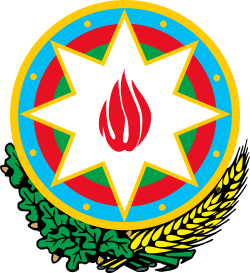Education in Azerbaijan

Education in Azerbaijan is regulated by the Ministry of Education of Azerbaijan.
History
In the pre-Soviet period, Azerbaijani education included intensive Islamic religious training that commenced in early childhood. Beginning at roughly age five and sometimes continuing until age twenty, children attended madrasahs, education institutions affiliated with mosques. In the seventeenth and eighteenth centuries, madrasahs were established as separate education institutions in major cities, but the religious component of education remained significant. In 1865 the first technical high school and the first women's high school were opened in Baku. In the late nineteenth century, secular elementary schools for Azerbaijanis began to appear (schools for ethnic Russians had been established earlier), but institutions of higher education and the use of the Azerbaijani language in secondary schools were forbidden in Transcaucasia throughout the tsarist period. The majority of ethnic Azerbaijani children received no education in this period, and the Azerbaijani literacy rate remained very low, especially among women. Few women were allowed to attend school.
In the Soviet era, literacy and average education levels rose dramatically from their very low starting point, despite two changes in the script, from Arabic to Latin in the 1920s and from Latin to Cyrillic in the 1930s. According to Soviet data, 100 percent of males and females (ages nine to forty-nine) were literate in 1970. According to the United Nations Development Program Report 2009, the literacy rate in Azerbaijan is 99.5 percent.[1]
During the Soviet period, the Azerbaijani education system was based on the standard model imposed by Moscow, which featured state control of all education institutions and heavy doses of Marxist–Leninist ideology at all levels.
Since independence, one of the first laws that Azerbaijan's Parliament passed was to adopt a modified-Latin alphabet to replace Cyrillic.[2] Other than that the Azerbaijani system has undergone little structural change. Initial alterations have included the reestablishment of religious education (banned during the Soviet period) and curriculum changes that have reemphasized the use of the Azerbaijani language and have eliminated ideological content. In addition to elementary schools, the education institutions include thousands of preschools, general secondary schools, and vocational schools, including specialized secondary schools and technical schools. Education through the nineth grade is compulsory. At the end of the Soviet period, about 18 percent of instruction was in Russian, but the use of Russian began a steady decline beginning in 1988. Today English and Russian are taught as second or third languages.
Universities

There are 36 state-run and 15 private universities in Azerbaijan. The ministry-released reports state that in 2009 20,953 undergraduate students and 3,526 graduate students entered in universities nationwide. Currently, there are 104,925 undergraduate and graduate students, studying in higher education institutions, excluding the specialized higher education schools. Universities employ 11,566 professors and 12,616 faculty members in the country.[3] Because Azerbaijani culture has always included great respect for secular learning, the country traditionally has been an education center for the Muslim peoples of the former Soviet Union. For that reason and because of the role of the oil industry in Azerbaijan's economy, a relatively high percentage of Azerbaijanis have obtained some form of higher education, most notably in scientific and technical subjects.[4] Several vocational institutes train technicians for the oil industry and other primary industries.
The most popular institutions of higher education are the Baku State University, Azerbaijan State Oil Academy (ASOA), Qafqaz University, Khazar University, Azerbaijan Technical University, the Pedagogical Institute, Mirza Fath Ali Akhundzade Pedagogical Institute for Languages, Azerbaijan Medical University, Uzeyir Hajibayov Baku Academy of Music. Much scientific research, which during the Soviet period dealt mainly with enhancing oil production and refining, is carried out by Azerbaijan National Academy of Sciences, which was established in 1945.
Baku State University (the University of Azerbaijan, established in 1919) includes more than a dozen departments, ranging from physics to Oriental studies, and has the largest library in Azerbaijan. The student population numbers more than 11,000, and the faculty over 600. The Institute of Petroleum and Chemistry, established in 1920, has more than 15,000 students and a faculty of about 1,000. The institute trains engineers and scientists in the petrochemical industry, geology, and related areas.
See also
- Ministry of Education of Azerbaijan Republic
- List of universities in Azerbaijan
- Khazar university
- Education in the Soviet Union (Historical)
References
- ↑ "Human Development Report 2009" (PDF). United Nations Development Program 2009. Retrieved 2009. Check date values in:
|access-date=(help) - ↑ "Education in Azerbaijan, The Challenges of Transition". Azerbaijan International. Retrieved Winter 1996. Check date values in:
|access-date=(help) - ↑ "ALİ VƏ ORTA İXTİSAS TƏHSİLİ SAHƏSİ ÜZRƏ 2009-CU İLDƏ GÖRÜLMÜŞ İŞLƏRƏ DAİR HESABAT" [Report on Works in Secondary and Higher Education Sector in 2009]. Retrieved 2010-11-04.
- ↑ "Azerbaijan: A Country Study, Education, Health, and Welfare". Country Studies.
![]() This article incorporates public domain material from the Library of Congress Country Studies website http://lcweb2.loc.gov/frd/cs/.
This article incorporates public domain material from the Library of Congress Country Studies website http://lcweb2.loc.gov/frd/cs/.
External links
- Education in Azerbaijan, UNICEF country profile
- Vocational education in Azerbaijan, UNESCO-UNEVOC country profile
